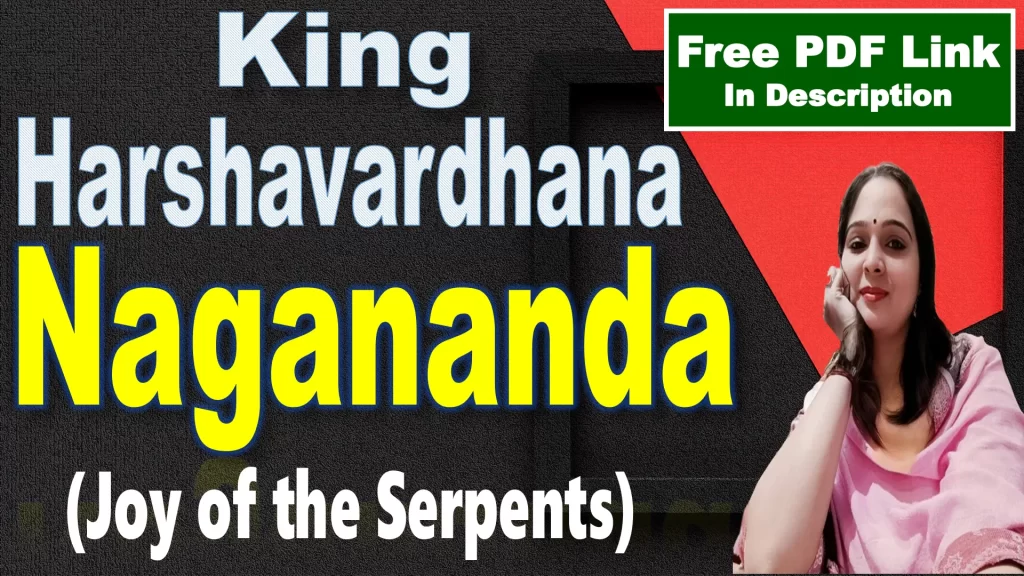
Nagananda by Harsha | Nagananda | Joy of the Serpents | Harsha | King Harshavardhana | Summary | Plot | Analysis | Characters | Themes | Style | Historical Context | Critical Analysis | Download Free PDF – Easy Literary Lessons
Nagananda by Harsha
Nagananda is a Sanskrit drama attributed to King Harsha (Harshavardhana), who ruled North India from 606 to 647 CE. Known for his patronage of the arts and literature, King Harsha composed three plays: Nagananda, Ratnavali, and Priyadarsika. Among these, Nagananda is regarded as his most significant work due to its unique combination of Buddhist philosophy, classical Indian dramaturgy, and compelling storytelling.
Nagananda was likely written during Harsha’s reign, a period characterized by a flourishing of arts and culture. Harsha, influenced by both Hinduism and Mahayana Buddhism, infused the play with Buddhist ideals, particularly the themes of compassion and self-sacrifice. The invocation to Lord Buddha in the opening Nandi verse highlights this influence.
The play’s central themes of duty, renunciation, and selflessness reflect the philosophical and ethical values of the time, resonating with Indian spiritual traditions.
Nagananda is classified as a Nataka, a traditional form of Sanskrit drama. It consists of five acts, adhering to the structure of classical Sanskrit dramaturgy as outlined in texts like the Natyashastra. The play stands out for blending romance, humor, and philosophical depth with dramatic and spiritual elements.
The play Nagananda, written by King Harsha, is a five-act Sanskrit drama that beautifully combines themes of love, sacrifice, and compassion. It tells the story of Jimutavahana, a Vidyadhara prince known for his selflessness and nobility, who sacrifices himself to save the Naga community from a cruel tradition.
The story begins with Jimutavahana, who renounces his throne to care for his aging parents and chooses a simple life in the forest. While in the forest, he meets Malayavati, a princess who has been promised by the goddess Gauri in a dream that she will marry a Vidyadhara prince. Jimutavahana and Malayavati fall in love, and their marriage is arranged with the support of her family. Their union represents the divine blessing and sets a joyful tone early in the play.
The drama takes a darker turn when Jimutavahana learns about a cruel agreement between Garuda, the king of birds, and Vasuki, the king of Nagas. According to this pact, a Naga is sacrificed to Garuda every day to prevent the total annihilation of the Naga race. On the day Jimutavahana and Malayavati are enjoying their married life, he discovers that Sankhachuda, a Naga prince, is next in line for the sacrifice. Deeply moved by the plight of the Nagas and horrified by the injustice, Jimutavahana decides to take Sankhachuda’s place in the ritual.
Jimutavahana’s compassion and courage shine through as he dons the red garments meant for the Naga sacrifice and ascends the execution rock where Garuda devours his victims. When Garuda arrives, he is initially unaware of the identity of his intended prey. However, Jimutavahana’s unwavering resolve and noble demeanor astonish him. Garuda realizes that Jimutavahana is not a Naga but a Vidyadhara prince who has offered himself to save another life. Overwhelmed by this extraordinary act of selflessness, Garuda feels deep remorse and vows to end the cruel tradition.
Meanwhile, Jimutavahana’s family, including his parents and Malayavati, learns of his sacrifice. They are devastated and prepare to end their lives in grief. At this crucial moment, Goddess Gauri intervenes, restoring Jimutavahana to life with divine ambrosia. Not only does she revive Jimutavahana, but she also brings back to life the Nagas who were previously sacrificed. The cycle of suffering is finally broken, and harmony is restored.
The play concludes with Jimutavahana being crowned as the universal emperor of the Vidyadharas, symbolizing the triumph of virtue and compassion. He requests blessings for the prosperity and happiness of his people, choosing the welfare of others over personal glory. The revival of the Nagas and the abolition of their suffering bring closure to the central conflict, fulfilling the title’s promise of “Joy of the Serpents.”
Nagananda is a profound tale of love, self-sacrifice, and the transformative power of compassion. Its characters, led by the heroic Jimutavahana, exemplify the highest ideals of humanity, making it a timeless story with universal appeal.





